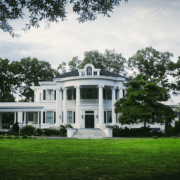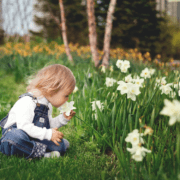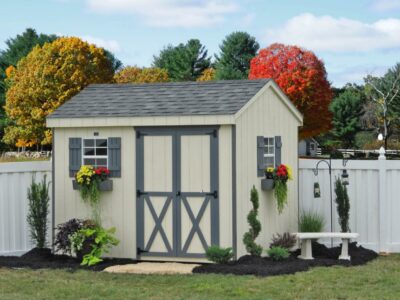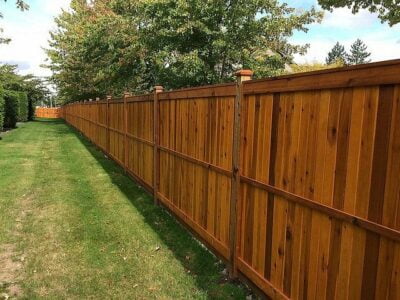Sometimes plants growing under trees can suffer from a lack of bright sunlight. This is especially true of plants that grow under an evergreen tree.
While deciduous trees offer dappled shade with a higher canopy, evergreens tend to have dense foliage that continues towards the base of the trunk. This produces a lovely full effect on the tree but severely limits the amount of sunlight and rainwater the plants underneath it can absorb.
Conifer trees are notoriously thirsty and soak up lots of moisture from the soil underneath, leaving little for other plants that grow in their shade.
On top of that, fallen pine needles can alter the pH of the soil, adding yet another barrier to some plants. While a carpet of needles might look in keeping with woodland areas, it’s not quite as inviting in the garden, where a combination of pretty annuals, perennials and shrubs is much preferred.
For this reason, it’s worth putting some thought and planning into the shrubs and flowers that grow best in these conditions. Many plants not only tolerate shady areas, but flourish in the year-round cover of evergreen trees. Creating eye-catching displays underneath evergreen trees is achievable – you just need to know what plants to look out for.
Check other evergreens out at Gardeners Dream.
Why Nothing Grows Under Fir Trees
It’s often said that nothing ever grows under fir trees, and while there is some truth in that statement, it’s not entirely accurate.
To grow plants under fir trees some issues need to be overcome. As mentioned above, a lack of light is the main one. But it’s also important to choose plants that are drought-tolerant, and grow well in acidic soil.
Luckily, there are plenty to choose from. Rather than relying on trial and error with plants that would really prefer a spot in full sun, do some research and get it right the first time.
The Best Ground Covers for Underneath an Evergreen Tree
Ground covers are low-growing plants that form a mat or carpet over the ground. They are ideal for covering areas of bare soil, helping to prevent soil erosion and suppressing weeds. Ground cover plants are often evergreen and are fast growing with a spreading habit that quickly hides the soil underneath.
Tall Fescue Grass (Festuca arundinacea)
You might think grass is a rather boring option for under your tree, but tall fescue grass provides excellent ground cover. It may not flower or produce bright red berries, but it is easy to look after and thrives in the shade. In fact, this grass turns brown quickly in high heat.
Tall fescue grass is drought tolerant, and its deep roots can seek out nutrients in almost any soil type.
Lily of the Valley (Convallaria majalis)
This hardy perennial boasts erect racemes of nodding flowers from late spring. These bell-shaped flowers are highly fragrant and spread easily, making them ideal ground covers.
Lily of the valley thrives in full shade and is perfect for prettying a woodland garden. It prefers damp shade, so is best planted under a tree in moist or poorly draining soil.
Always wear gardening gloves when handling a lily of the valley plant, as it can cause skin irritation.
Ivy (Hedera)
Ivy can grow almost anywhere, in any light conditions, from full sun to full shade. Its spreading habit makes it perfect for ground cover, but it also climbs tree trunks, extending the effect upwards without harming the tree.
Evergreen leaves provide year-round greenery, with some species’ glossy green leaves variegated for added interest. Green yellow flowers appear on mature plants in autumn and are a valuable nectar source for late pollinators. The flowers are followed by large black berries, providing food for birds and small mammals throughout winter.
When choosing a variety of ivy to grow, bear in mind that common ivy (also known as English ivy) prefers slightly alkaline soil. If pine trees have left you with acid soil, choose a different variety, such as Persian ivy.
The Best Perennial Plants to Grow Under Pine Trees
While some shrubs and trees are technically perennials, the term is usually used to describe plants without any woody growth that live for more than two years.
There are two types of perennial plants – herbaceous and evergreen. Herbaceous perennials die back and retreat below ground level in autumn and winter before re-emerging and growing back to their full size in spring. Evergreen perennials keep their foliage all year round.
Plantain Lily (Hosta)
Plantain lilies are usually grown for their large, attractive foliage, but they do flower in mid-late summer. These herbaceous perennials are shade-loving plants that thrive in well-drained soil. Hostas prefer partial shade but tolerate full shade well.
Tall, erect stems sprout from the centre of the plant in summer and bear clusters of purple or white flowers. However, the main attraction of the plantain lily is the large leaves, which are often variegated and provide plenty of interest from spring to autumn.
Hostas will die back below ground level for winter but re-emerge the following spring, quickly growing back into their prime.
Columbine (Aquilegia vulgaris)
Also known as granny’s bonnet, columbine is a flowering perennial often found in woodland areas. Tall flower stalks appear in late spring and early summer, bearing blooms in an array of colours. Some varieties bloom soft pink flowers or white flowers, while others produce bolder red or blue hues.
Aquilegias are easy to grow from seed and are often brought indoors as part of a display of cut flowers. The blooms are irresistible to bees and are a valuable source of spring nectar. This hardy perennial grows well in partial shade and prefers light, well-drained soil.
Snowdrops (Galanthus nivalis)
One of the first plants to flower in the new year, the emergence of snowdrops is a sign that winter is almost over and spring is on the way. The pure white flowers are complemented by long, arching bright green leaves and bloom from late winter to early spring, providing ground cover when little else is flourishing in the garden.
Snowdrops thrive in moist soil in partial or dappled shade. They are easy to grow from bulbs and don’t need any pruning, as they should be allowed to die back naturally at the end of their season. Early bees and other pollinating insects love the nectar-rich white flowers.
The Best Shrubs for Under Pine Trees
Shrubs are medium-large-sized plants with woody stems growing above the ground. They are shorter than trees and have many woody stems rather than a central trunk.
Shrubs can be deciduous, losing their leaves in autumn, or evergreen, keeping their foliage throughout the year. Many produce flowers and berries, while others are grown solely for their attractive foliage. Shrubs come in all shapes and sizes, with lower-growing specimens making an excellent ground cover for under pine trees.
Checkerberry (Gaultheria procumbens)
This evergreen dwarf shrub is ideal for complementing the jagged needles of conifers. Checkerberry is a relatively low-growing shrub with an ultimate height of 15-30cm. However, it spreads as far as 150cm, making it a great choice for under-tree planting.
Also known as wintergreen, checkerberry boasts glossy green, round, leathery leaves that take on a reddish hue in winter. Small, light pink or white flowers bloom in summer, closely followed by large scarlet berries through autumn.
This eye-catching shrub is easy to grow and thrives in partial shade or full shade. It is hardy to cold winter temperatures and grows well in acidic soil. The Royal Horticultural Society has given Gaultheria procumbens its Award of Garden Merit, which is the RHS seal of approval for reliability and pest resistance.
Rhododendron and Azalea (Rhododendron spp.)
Growing well in acidic soil, rhododendron and azalea shrubs are ideal for planting beneath pine trees. They have below-average watering needs, so won’t be fazed by the tree roots absorbing most of the moisture from the soil underneath.
Both plants come under the rhododendron genus, with azaleas being the more compact species. Rhododendrons are usually evergreen, while azaleas can be evergreen or deciduous. A wide selection of cultivars is available, with different varieties producing flowers in glorious shades of pink, red, purple, blue, yellow, orange and white.
These popular garden shrubs flower from early spring to mid-summer, almost completely covering the lush green foliage.
Holly (Ilex aquifolium)
The glossy green leaves and bright red berries of a holly bush contrast beautifully with the spiky pine needles of conifer trees and create a striking winter display of greenery. Common holly is often found growing naturally under pine trees. It is a low-maintenance shrub that can thrive in a shady area.
Holly is a slow-growing shrub that does well in acidic soil. It produces tiny white flowers in late spring and early summer and provides food and shelter for birds and small mammals.
The Best Ferns for Growing Under an Evergreen Tree
Ferns are hardy perennials that don’t flower, reproducing by producing spores instead. When the spores land on a suitable surface, they germinate and grow. The foliage on fern plants has a light, airy feel, with fronds made up of several mid-green to dark-green leaves.
With their interesting texture and vibrant foliage, ferns are a popular choice of plant to grow under pine trees.
Soft Shield Fern (Polystichum setiferum)
Soft shield ferns are native to the UK and thrive in the British climate. They grow well in acidic to neutral soil and are hardy to harsh winter temperatures. Soft dark green foliage forms upright fronds that spill over to create an arching effect as they mature.
Soft shield ferns flourish in full or partial shade in moist, well-draining, fertile soil. Soft shield is a dwarf variety of fern with double pinnate foliage and green fruits in summer.
Christmas Fern (Polystichum acrostichoides)
Another evergreen fern, this plant boasts narrow fronds of leathery foliage separated into pairs of dark green leaflets. Christmas ferns grow up to 1m tall and wide and are well-suited to all soil types. They are hardy to UK winter temperatures and grow best in full or partial shade.
Christmas ferns are low-maintenance plants that don’t require much attention to thrive. Other than cutting away any dead or damaged fronds, these hardy ferns don’t need any pruning to keep them tidy. They are fully mature within 5-10 years and are generally free of pests and diseases.
Japanese Tassel Fern (Polystichum polyblepharum)
Another recipient of the RHS Award of Garden Merit, the Japanese tassel fern is an easy-to-grow evergreen with a unique appearance. The erect, lance-shaped fronds grow stiffly to produce a shuttlecock effect. New fronds emerging in spring are covered in fine golden hairs, giving the illusion of tassels – hence the name.
This architectural plant is ideal for year-round interest under pine trees. It thrives in full or dappled shade and is fully hardy in the UK. Japanese tassel fern is resistant to deer and rabbits and is generally pest-free. It’s a low-maintenance garden plant, and all that is needed is a quick prune to remove damaged leaves in mid to late spring.
How to Grow More Successfully Beneath a Tree
Planting under a coniferous tree has its challenges, and you’d be forgiven for adding a layer of mulch around the base of the trunk and forgetting about it. However, with a bit of know-how, you can create a striking display beneath conifers.
You may want to consider pruning some of the lower branches on the tree. As the foliage gets closer to the ground, more sunlight is blocked from the area beneath an evergreen tree. Cutting back some of these low-growing branches can help plants that grow in the same area by providing them with more light.
Native plants have a much higher success rate than those that have been imported. A locally sourced native plant is acclimatised to the environment and re more likely to survive in full shade.
The key to growing plants under an evergreen tree is to research in advance. Before purchasing, look up the plant’s light and watering needs to check it will grow in the shade of a tree. Test the soil pH and, if necessary, opt for plants that grow in the acidic soil around a pine tree.
Whether you’re looking for ground cover, flowers or attractive foliage in a plant, there are plenty of options that will look stunning as they thrive in the shade of your tree.










Comments